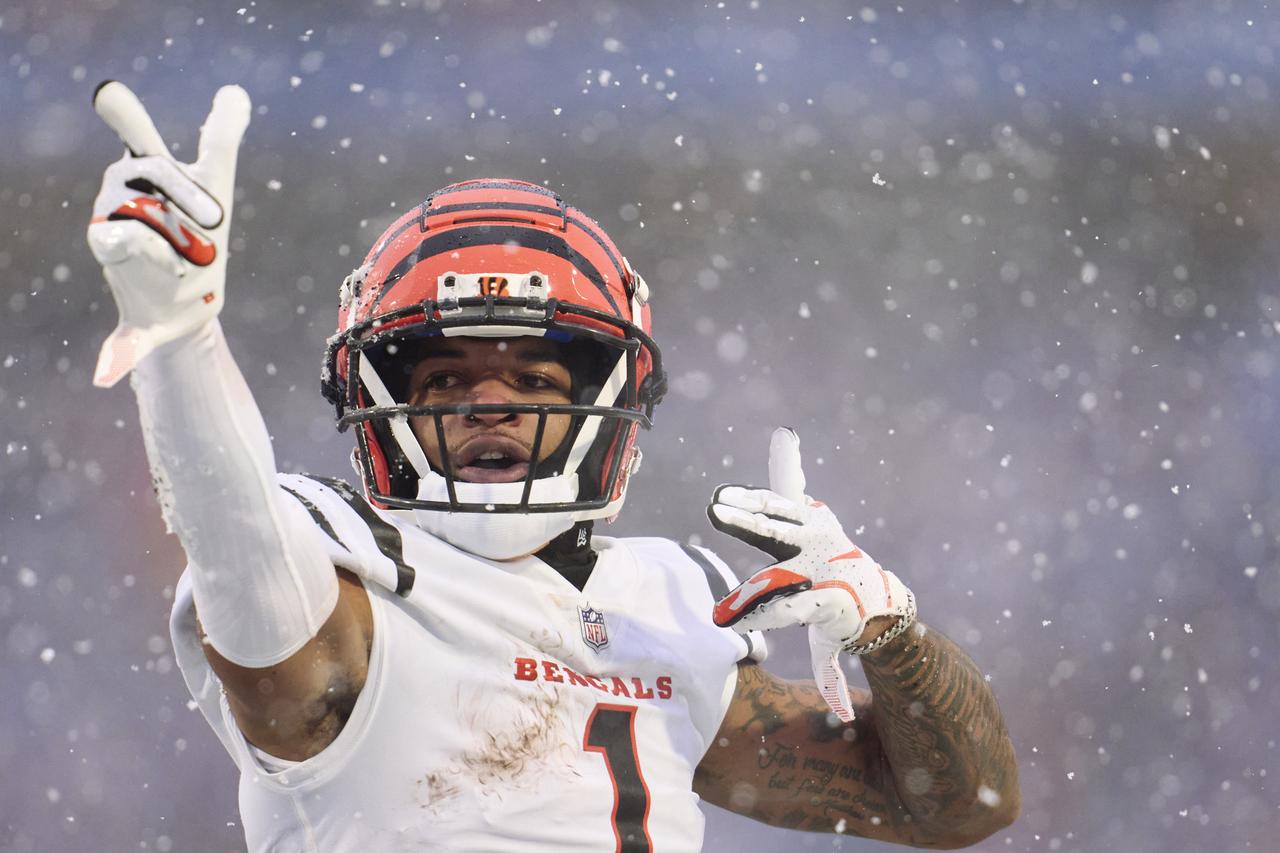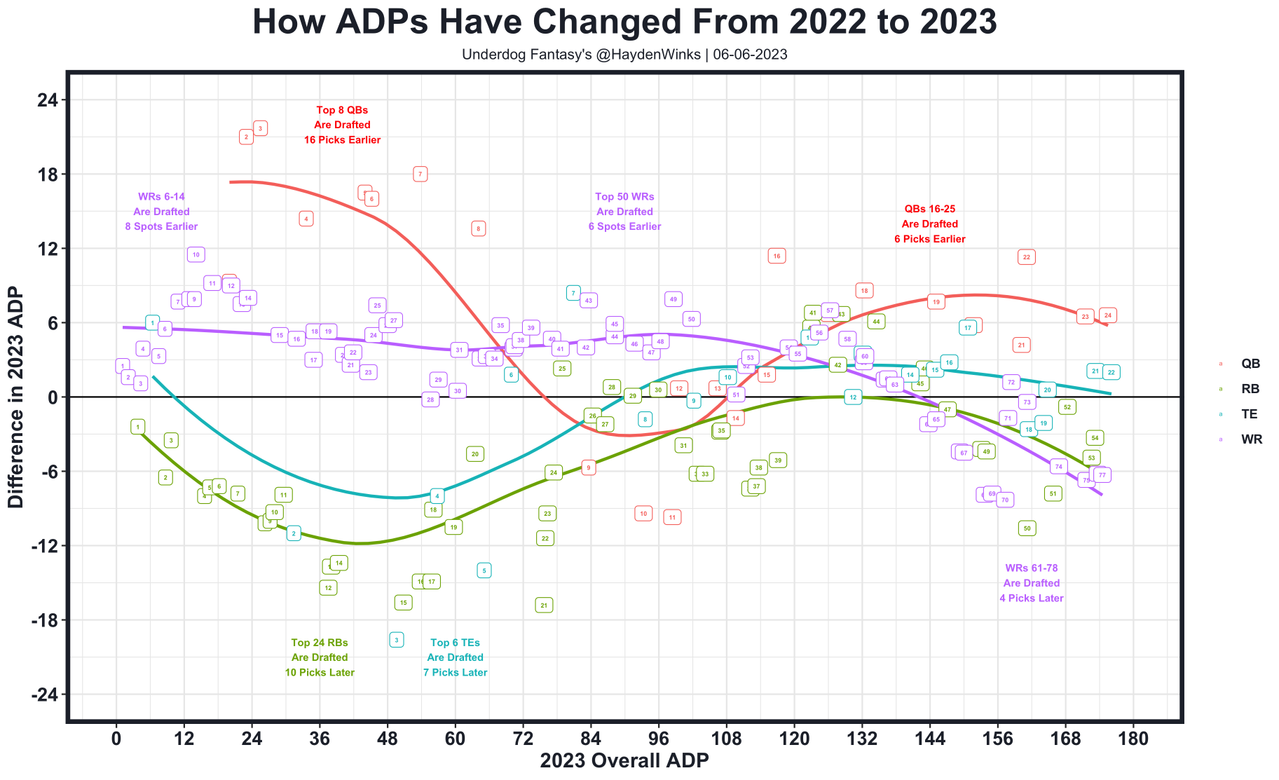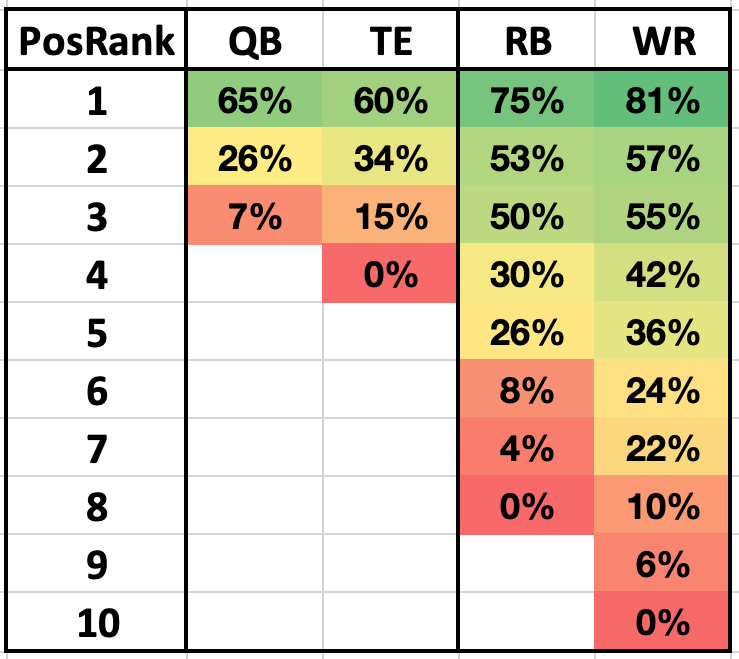Strategy Data For Underdog Fantasy's Weekly Winners

Underdog Fantasy launched "Weekly Winners" last month, and ever since then, there's been a lot of theory-based strategy on how to win this new styled game. I have done my own theorizing and podcasting on this topic, but I'm now trying to apply some data to the equation. It's not perfect because this data is based on Best Ball Mania III drafts where our goals aren't exactly the same as in Weekly Winners. But I won't let perfection stand in the way of progress. I think I found some takeaways that pass my theory-based smell test below.
As always, you can try Weekly Winners or Pick'em with the promotion link below. We'll match your first deposit up to $100.
How Many Points Needed For Top 1% Teams?

This graphic shows how many points each player scored if they were starting in a top 1% weekly lineup last year. The "TE1" refers to the first TE drafted on a team, not the highest scoring TE on that team. Same with "WR2", "RB3", "QB1", etc.
TEs averaged about 17-18 half PPR points. QBs averaged about 29-30 points. RBs averaged about 21-22 points. WRs averaged about 18-19 points. That gives us a nice baseline of just how much weekly upside a player needs to be draftable in Weekly Winners, though the 1st place team that wins $20,000 will need to considerably beat these thresholds.
To expand on that, here's a thiccccc table that shows how often a player has reached these thresholds over the last two seasons. My "Weighted Rank" is just a combination of spikes, the percentage of spikes at their position, and how many points they scored on top of the minimum spike threshold at their position. These are NOT my Weekly Winners rankings. I also doubled the spikes for all rookies or players that missed one of the entire 2021 or 2022 seasons to make their rates fairer for young players.
It's remarkable just how much the truly elite WR1s have separated from the pack over the last two seasons. I'm not talking about the low-end WR1s. I'm talking about Davante Adams, Cooper Kupp, Justin Jefferson, and Tyreek Hill. These dudes have been monsters and why that "WR1" tab in the first image is lapping the "WR2" label. I think we need to acknowledge the difference between the tiers of the true WR1s and the fringe WR1/2s. It seems like we're trying to put the Chris Olave tier into the Davante Adams tier right now. Olave, by the way, didn't have a single half PPR game over 20 points last year. He's the only non-rookie player in the top-75 without a spike over the last two years.
It's also interesting to see that when a "WR6" or later does crack the starting lineup of an elite team, that player is adding the fewest points to the lineup. Because we obsess over WRs in fantasy now, it's harder to find legit upside at the position late in drafts. Players who do hit as WR dart throws typically look like Zay Jones, who was the WR25 in my spike week metric below. That's dope, but the ceiling of the late-round WRs are really low in my opinion. Even the "WR4" and "WR5" groups from the first chart don't add that much value on average.
The RB1 spikes exactly matched the WR1 spikes on average, but there was a lean towards RBs when it comes to "RB2" vs. "WR2" (22.6 vs. 19.7) and "RB3" vs. "WR3" (22.0 vs. 18.6). This data, to me, is showing that when you hit on a RB, his value is better than the WR at the same draft range. His upside is higher on a weekly basis. That's why there were 22 RBs to 20 WRs in the top-60 of this player list for example. There will be a lot of busts at RB, which is why WRs have been good picks in Best Ball Mania in this range, but this Weekly Winners format gears toward ultimate upside, not 50th or 80th percentile outcomes like in normal best ball.
Things get very complicated at TE. Travis Kelce (7th in weighted rank), Mark Andrews (8th), and George Kittle (11th) look better in this metric than I was expecting. These TEs have been the only TEs that have separated well beyond the 18-19 point threshold in a given week on a semi-regular basis. That makes them valuable for sure (if they can keep it up as they get older). However, there are a lot more TEs than people realize that will score at least 18-19 points. In fact, over the last two seasons 29 of them have, and 18 TEs have at least two spike weeks. These include some very gross names who go well into the double digit rounds. Overall, I think the 3- and 4-TE strategy is a good one, as we ride the volatility of the position, especially because they can crack your starting lineup in the flex on occasion.
QB is far more straight forward. Only 19 QBs have met the 29-30 point threshold over the last two seasons, and only 10 QBs have done so at least twice. We are very good at projecting QB fantasy points now, and the elite QB1s are all in the primes of their career. It's possible for mid- and late-round QBs to come near this threshold, but they're big dogs to do it more than once and they're big dogs to score a lot of points beyond the threshold. Overall, I'm trying to get one of the top-7 QBs and will add a QB2 if stacked properly at a reasonable ADP.
How Often Does Each Position Fill The Flex?
RB: 49% of the time
WR: 39%
TE: 12%
This is interesting to me because when I polled Twitter on how often they thought a WR started in the flex on these elite teams, they severely overestimated how often it happens. This narrative explains why WRs are being drafted so much earlier than RBs this season:

Josh Jacobs was the RB24 in ADP at 71st overall last year, while DeVonta Smith was the WR36 at 74th overall. In general, the RBs and WRs were pacing with each other at this 2:3 rate for most of the draft in this sample. This year, WRs are priced up over the RBs, especially in the first 8 rounds of the draft. I've been drafting RBs into my flex a lot in this format because of the ADP to upside projection value. I love a Saquon Barkley, Josh Jacobs, Dameon Pierce start through six rounds right now.
Where Do Starting Players Get Drafted At?

This chart shows how often a player is in the starting lineup of a top 1% weekly team, based on when they were drafted. For example, the drafted WR1 on an elite team is in the starting lineup 81% of the time on average, which is the highest rate of any position.
But the real takeaway is how diminishing returns work at all positions, not just at QB or TE. The QB3 only cracked the lineup 7% of the time. The RB6 only cracked the lineup 8% of the time. And the WR8 only cracked the lineup 10% of the time. This is more evidence on why we should be viewing roster construction through 8-12 rounds of the draft, not all 18. The final picks of our drafts are usually very forgettable.
At the same time, we still have to make late-round picks and we want them to help us out on the margins. Let's say almost all of our Weekly Winners teams will have at least 1 QB, 4 RBs, 6 WRs, and 1 TE. That means we're debating the contributing odds for 6 other picks. Here's how they'd rank based on last year's data: TE2 (34%), RB5 (26%), QB2 (26%), WR7 (22%), TE3 (15%), and WR8 (10%). That means on average, the elite weekly teams had a 2-5-8-3 teams. That's exactly what it looks like usually ... because diminishing returns at each position matter.
Of course, these averages are just that: averages. When you are building a lopsided team (Zero RB, Robust RB, 2nd Round QB, 3rd Round TE, etc.), then you need to make adjustments that skew towards more quantity at positions you've faded early on. It's still hilarious to me that I can't post (free) data on Twitter without someone reminding me that the one tweet didn't hit on the nuance of their recently drafted team. Turns out, I can't solve every team with one piece of data!!! Thanks for the reminder!
How Many Unique NFL Teams In A Starting Lineup?
7 teams (1 single stack) - 42%
6 teams (2 single stacks or 1 double stack) - 31%
8 teams (0 stacks) - 17% of the time
5 teams (3 single stacks or 2 double stacks) - 9%
4 teams (lots of stacks) - 1%
I really just want my QB paired with 1 WR or 1 TE on most builds. Of the elite teams last year, 42% of them had just 1 single stack in their starting lineup. It's even crazier to think that 17% of elite weekly teams had 0 NFL teammates in their starting lineup!!! Beyond that, there were 31% of teams that had 6 NFL teams in their starting lineup, which could be 2 single stacks or 1 double stack. If you add all of these up, more than 3-in-4 elite weekly teams aren't over stacking one particular NFL team.
If I am double stacking an NFL team, I'm more open to it when:
The NFL team has lots of passing production
The double stack includes a TE
The NFL team is cheap in ADP
How Many Stacked WRs In A Starting Lineup?
All WRs from unique NFL teams: 84%
1 WR teammate pairing: 15%
Multiple WR teammate pairings: 1%
As I alluded to earlier, betting against your top players is problematic when we're competing for elite scores in a one week sample. Last year's elite single-week teams started multiple WRs from the same team just 15% of the time, but the narrative around Weekly Winners is to pound team stacks. Bigger team stacks are better in Best Ball Mania drafts, however, for a few reasons.
In Weekly Winners, we're competing against 261,000 teams. We need elite scores where everything is breaking our way. In BBM, we're competing against just 11 teams from Weeks 1-14, then just 15 teams in Week 15 and Week 16, and then just 441 teams in the finals if we make it there. The difference between them is outrageously large. Here is Dooley's chart comparing Pat Kerrane's BBM winning team compared to what it takes to win in Weekly Winners:
The good news is a lot of drafters are drafting poor teams. There's a big edge in this contest right now because drafters are over stacking. If we look at the differences between BBM and WW average draft positions, we can clearly see how the players on elite teams are being pushed up even more in Weekly Winners. Just last week, Kadarius Toney was being drafted before Chris Godwin!!! That only happens because the narrative around Weekly Winners is to go ham with stacks.